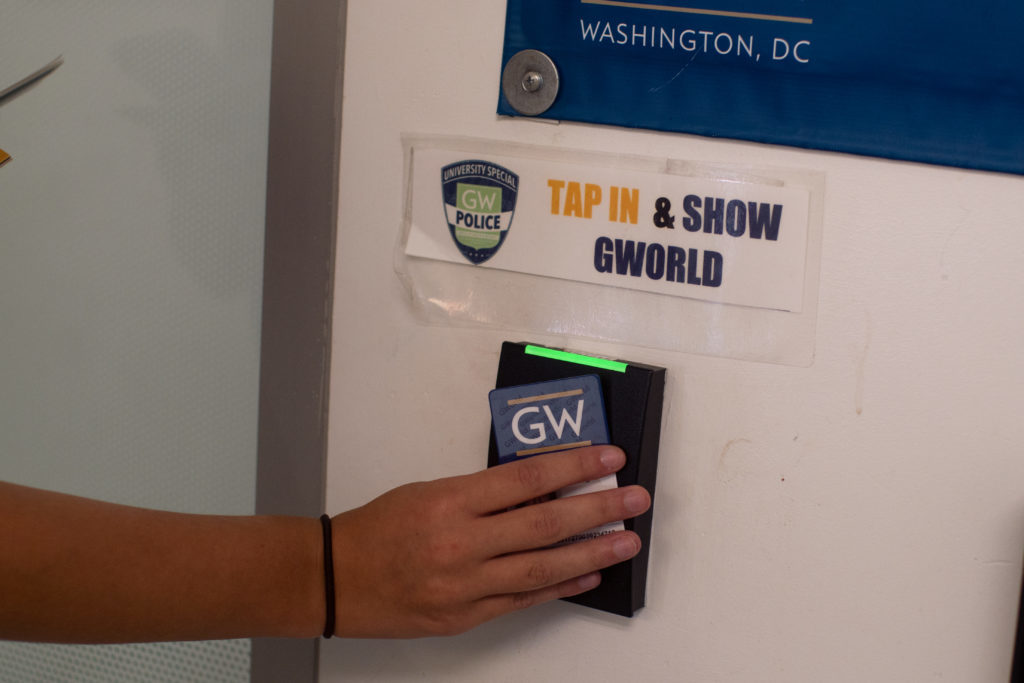The University employs about 50 percent more student access monitors than they did this time last academic year.
Officials said they hired 125 SAMs this fall to check student IDs at the entrance of residence halls, compared with 82 SAMs last year. The additional hires will help keep the department staffed in case the University needs to find replacements throughout the semester, officials said.
Kathleen Fox, the assistant vice president of health and safety, said SAMs make a record of everyone who enters the residence hall, which tightens safety on campus because they ensure only students enter each residence hall. Officials granted all on-campus undergraduates tap access to every residence hall this fall.
“SAMs are our real-time eyes and ears around campus,” Fox said in an email. “They are trained to identify students in distress, safety hazards and other facilities issues. Ultimately, they ensure that the security features in our residence halls are not being bypassed.”
Fox added that hiring more SAMs does not ensure that all residence halls are covered, because officials may prioritize placing more SAMs at certain residence halls. The Hatchet reported in November that several residence halls did not have SAMs stationed at entrances for the majority of the day.
“Increasing numbers will help with some buildings that historically weren’t covered, but more importantly it will help keep our coverage consistent around campus,” Fox said.
In interviews, SAMs who spoke on the condition of anonymity because they are not allowed to speak with media organizations, said an increased presence in residence halls ensures that people unaffiliated with GW will not enter the buildings.
One SAM said he didn’t know if increasing the number of SAMs would improve safety on campus, because some supervisors leave entrances without a SAM when there are not enough employees available to cover each residence hall. He said his supervisors prioritize stationing SAMs at freshman residence halls, but he did not receive a response when he asked his supervisor.
The SAM said that he and other workers have heard students question why SAMs should be at residence halls during his shifts. The student said that SAMs sign in visitors who are unaffiliated with GW and create an entrance record to ensure that all residents tap in, so a hiring push could curb concerns of non-students entering residence halls after the transition to an all-tap system.
“I said, ‘Why do you guys prioritize freshman buildings?’ and I just don’t get an answer,” he said. “It’s not my business.”
Another SAM said officials aimed to increase the number of SAMs after a slate of new senior supervisors wanted to station a monitor at each residence hall 24 hours per day.
“I think they are just trying to get closer to full coverage across the day,” the student said. “I think it’s what the goal was.”
The SAM said that in the coming months all SAMs will be assigned to the same two or three residence halls for every shift. SAMs previously reported to the Eye Street entrance of District House at the beginning of their shifts, where they were randomly assigned to a residence hall for the duration of their shift, the SAM said.
The student said supervisors have added more time slots in more residence halls instead of just the freshman residence halls where SAMs are typically allocated, which allows him to sign up for any shift he wants.
He said that last year, the program did not cover all residence halls, which made trying to find shifts “impossible” because SAMs were limited in the residence halls they covered. Security monitors were present during 2 percent of all checks in Amsterdam Hall and in 4 percent of checks in South Hall last fall.
“They’ve changed that and they’ve really opened up all of the shifts,” the SAM said.





